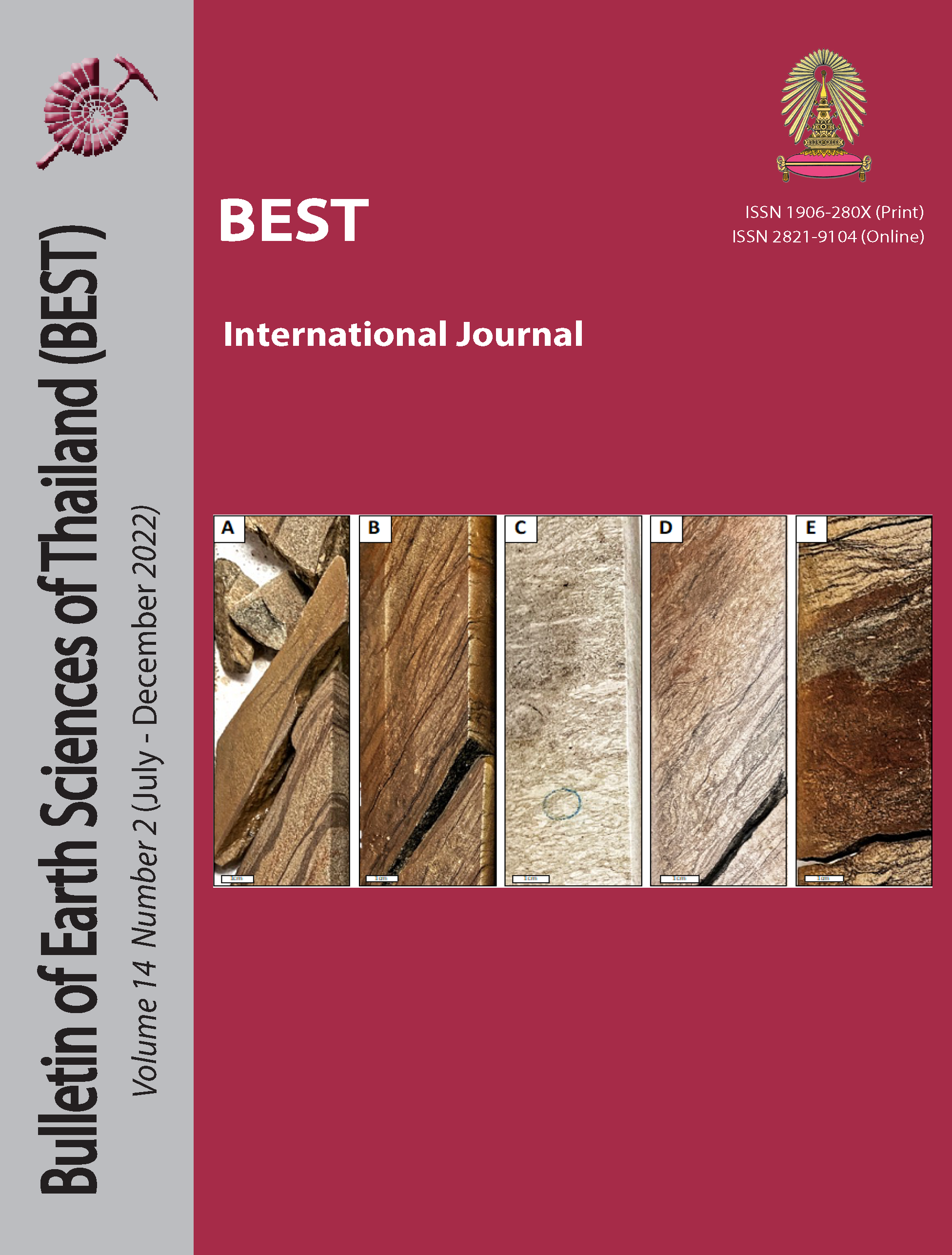Fold characteristics and deformation styles within fold and thrust belts using 2D numerical modelling
Main Article Content
Abstract
This study used Discrete Element Modelling (DEM) to simulate the two-dimensional structural deformation within fold and thrust belts that are associated with plate collision. A total of 12 models were performed with different basal inclinations and pre-kinematic thickness. The results reveal that the thrust-related structures are dominated by pop-up structure and triangle zone. These structures commonly exhibit a kink band style folding in the hanging wall. The location of the active frontal fold, fold spacing, and fold types are controlled by pre-kinematic thickness. Thickermodels are characterized by box-type folds, while thinner models are characterized by chevron-type folds. Hence, the difference in the pre-kinematic thickness will have a significant impact on the folding structure, while the basal inclination has no effect based on our structural analysis.
Article Details

This work is licensed under a Creative Commons Attribution-NonCommercial-NoDerivatives 4.0 International License.
Copyright © 2008 Department of Geology, Faculty of Science, Chulalongkorn University. Parts of an article can be photocopied or reproduced without prior written permission from the author(s), but due acknowledgments should be stated or cited accordingly.
References
Benesh, N. P., Plesch, A., Shaw, J. H., and Frost, E. K., 2007, Investigation of growth fault bend folding using discrete element modeling: Implications for signatures of active folding above blind thrust faults: Journal of Geophysical Research: Solid Earth, v. 112, no. B3.
Dean, S., Morgan, J., and Brandenburg, J. P., 2015, Influence of mobile shale on thrust faults: Insights from discrete element simulations: AAPG Bulletin, v. 99, no. 3, p. 403-432.
Dean, S. L., Morgan, J. K., and Fournier, T., 2013, Geometries of frontal fold and thrust belts: Insights from discrete element simulations: Journal of Structural Geology, v. 53, p. 43-53.
Finch, E., and Gawthorpe, R., 2017, Growth and interaction of normal faults and fault network evolution in rifts: insights from three-dimensional discrete element modelling: Geological Society, London, Special Publications, v. 439, no. 1, p. 219.
Graveleau, F., Malavieille, J., and Dominguez, S., 2012, Experimental modelling of orogenic wedges: A review: Tectonophysics, v. 538-540, p. 1-66.
Hardy, S., 2018, Coupling a frictional-cohesive cover and a viscous substrate in a discrete element model: First results of application to thick- and thin-skinned extensional tectonics: Marine and Petroleum Geology, v. 97, p. 32-44.
-, 2019, Discrete element modelling of extensional, growth, fault-propagation folds: Basin Research, v. 31, no. 3, p. 584-599.
Hardy, S., and Finch, E., 2005, Discrete-element modelling of detachment folding: Basin Research, v. 17, no. 4, p. 507-520.
-, 2007, Mechanical stratigraphy and the transition from trishear to kink-band fault-propagation fold forms above blind basement thrust faults: A discrete-element study: Marine and Petroleum Geology, v. 24, no. 2, p. 75-90.
Hardy, S., McClay, K., and Anton Muñoz, J., 2009, Deformation and fault activity in space and time in high-resolution numerical models of doubly vergent thrust wedges: Marine and Petroleum Geology, v. 26, no. 2, p. 232-248.
Hudleston, P. J., 1973, Fold morphology and some geometrical implications of theories of fold development: Tectonophysics, v. 16, no. 1, p. 1-46.
Huiqi, L., McClay, K. R., and Powell, D., 1992, Physical models of thrust wedges, in McClay, K. R., ed., Thrust Tectonics: Dordrecht, Springer Netherlands, p. 71-81.
Li, J., Zhang, Y., Wang, H., and Wang, D., 2020, Three-dimensional discrete element numerical simulation of Paleogene salt structures in the western Kuqa foreland thrust belt: Petroleum Exploration and Development, v. 47, no. 1, p. 68-79.
McClay, K. R., 1990, Deformation mechanics in analogue models of extensional fault systems: Geological Society, London, Special Publications, v. 54, no. 1, p. 445.
McClay, K. R., and White, M. J., 1995, Analogue modelling of orthogonal and oblique rifting: Marine and Petroleum Geology, v. 12, no. 2, p. 137-151.
Meng, Q., and Hodgetts, D., 2019a, Combined control of décollement layer thickness and cover rock cohesion on structural styles and evolution of fold belts: A discrete element modelling study: Tectonophysics, v. 757, p. 58-67.
-, 2019b, Structural styles and decoupling in stratigraphic sequences with double décollements during thin-skinned contractional tectonics: Insights from numerical modelling: Journal of Structural Geology, v. 127, p. 103862.
Morgan, J. K., 2015, Effects of cohesion on the structural and mechanical evolution of fold and thrust belts and contractional wedges: Discrete element simulations: Journal of Geophysical Research: Solid Earth, v. 120, no. 5, p. 3870-3896.
Morley, C. K., King, R., Hillis, R., Tingay, M., and Backe, G., 2011, Deepwater fold and thrust belt classification, tectonics, structure and hydrocarbon prospectivity: A review: Earth-Science Reviews, v. 104, no. 1, p. 41-91.
Poblet, J., and Lisle, R. J., 2011, Kinematic evolution and structural styles of fold-and-thrust belts: Geological Society, London, Special Publications, v. 349, no. 1, p. 1.
Ruh, J. B., Kaus, B. J. P., and Burg, J.-P., 2012, Numerical investigation of deformation mechanics in fold-and-thrust belts: Influence of rheology of single and multiple décollements: Tectonics, v. 31, no. 3.
Soto, R., Casas, A. M., Storti, F., and Faccenna, C., 2002, Role of lateral thickness variations on the development of oblique structures at the Western end of the South Pyrenean Central Unit: Tectonophysics, v. 350, no. 3, p. 215-235.
Wu, J. E., and McClay, K. R., 2011, Two-dimensional Analog Modeling of Fold and Thrust Belts: Dynamic Interactions with Syncontractional Sedimentation and Erosion, in McClay, K., Shaw, J., and Suppe, J., eds., Thrust Fault-Related Folding, Volume 94, American Association of Petroleum Geologists, p. 0.
Yang, X., Peel, F. J., McNeill, L. C., and Sanderson, D. J., 2020, Comparison of fold-thrust belts driven by plate convergence and gravitational failure: Earth-Science Reviews, v. 203, p. 103136.
Zhang, T., 2012, Numerical modelling of deformation within accretionary prisms.
Zhang, Y., Li, J., Lei, Y., Yang, M., and Cheng, P., 2020, 3D simulations of salt tectonics in the Kwanza Basin: Insights from analogue and Discrete-Element numerical modeling: Marine and Petroleum Geology, v. 122, p. 104666.


